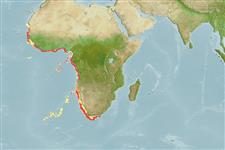Élasmobranches (requins et raies) (sharks and rays) >
Rajiformes (Skates and rays) >
Rajidae (Skates)
Etymology: Dipturus: Greek, di = two + Greek, pteryx = fin (Ref. 45335).
Eponymy: Do Tu dupl (Ref. 128868), visit book page.
Environment: milieu / climate zone / profondeur / distribution range
Écologie
marin bathydémersal; profondeur 163 - 1200 m (Ref. 11284), usually 450 - 600 m (Ref. 36731). Deep-water; 21°N - 37°S, 20°W - 27°E (Ref. 114953)
Eastern Central Atlantic to Southwest Indian Ocean: off Mauritania to South Africa (east to Cape Province) (Ref. 114953).
Taille / Poids / Âge
Maturité: Lm ? range ? - ? cm
Max length : 115 cm TL mâle / non sexé; (Ref. 114953)
Description synthétique
Clés d'identification | Morphologie | Morphométrie
an all-dark longnose skate with an elongated, acutely triangular snout, and a stout tail - shorter than body and with mid-section swollen sausage-shaped; disc with narrowly rounded outer corners and smooth underside except for small denticles on snout; no thorns on nape or along back (Ref. 5578). Dark brown with irregular dark blotches dorsally; rear end of disc and pelvic fins blackish; underside dark brown with black pores and scattered lighter blotches on disc, at base of pelvic fins, around vent, and on tail (Ref. 5578).
Body shape (shape guide): other.
Occurs in deeper slope waters (Ref. 4426). Feeds on benthic fishes, shrimps and crabs (Ref. 27637, Ref. 114953). Oviparous (Ref. 50449). Eggs have horn-like projections on the shell (Ref. 205). Males reaches maturity at ca. 101 cm TL (Ref. 114953).
Life cycle and mating behavior
Maturité | Reproduction | Frai | Œufs | Fécondité | Larves
Oviparous, paired eggs are laid. Embryos feed solely on yolk (Ref. 50449).
McEachran, J.D. and K.A. Dunn, 1998. Phylogenetic analysis of skates, a morphologically conservative clade of elasmobranchs (Chondrichthyes: Rajidae). Copeia 1998(2):271-290. (Ref. 27314)
Statut dans la liste rouge de l'IUCN (Ref. 130435: Version 2025-1)
Menace pour l'homme
Harmless
Utilisations par l'homme
Pêcheries: commercial
Outils
Articles particuliers
Télécharger en XML
Sources Internet
Estimates based on models
Preferred temperature (Réf.
123201): 6.3 - 11.8, mean 7.3 °C (based on 17 cells).
Phylogenetic diversity index (Réf.
82804): PD
50 = 0.5000 [Uniqueness, from 0.5 = low to 2.0 = high].
Bayesian length-weight: a=0.00282 (0.00131 - 0.00604), b=3.25 (3.08 - 3.42), in cm total length, based on LWR estimates for this Genus-body shape (Ref.
93245).
Niveau trophique (Réf.
69278): 3.8 ±0.66 se; based on food items.
Résilience (Réf.
120179): Faible, temps minimum de doublement de population : 4,5 à 14 années (Assuming fecundity<100).
Fishing Vulnerability (Ref.
59153): High to very high vulnerability (69 of 100).
🛈
